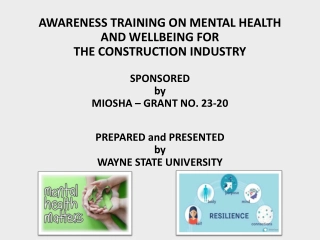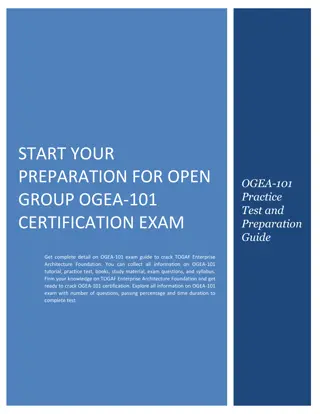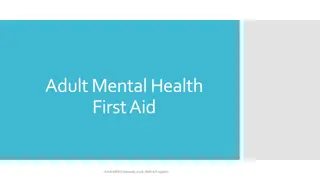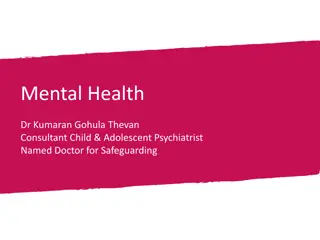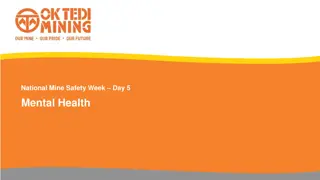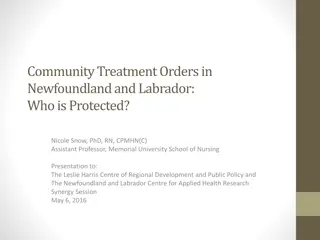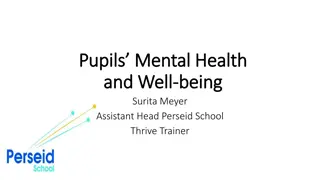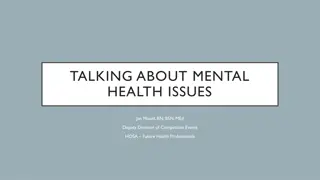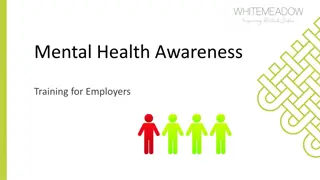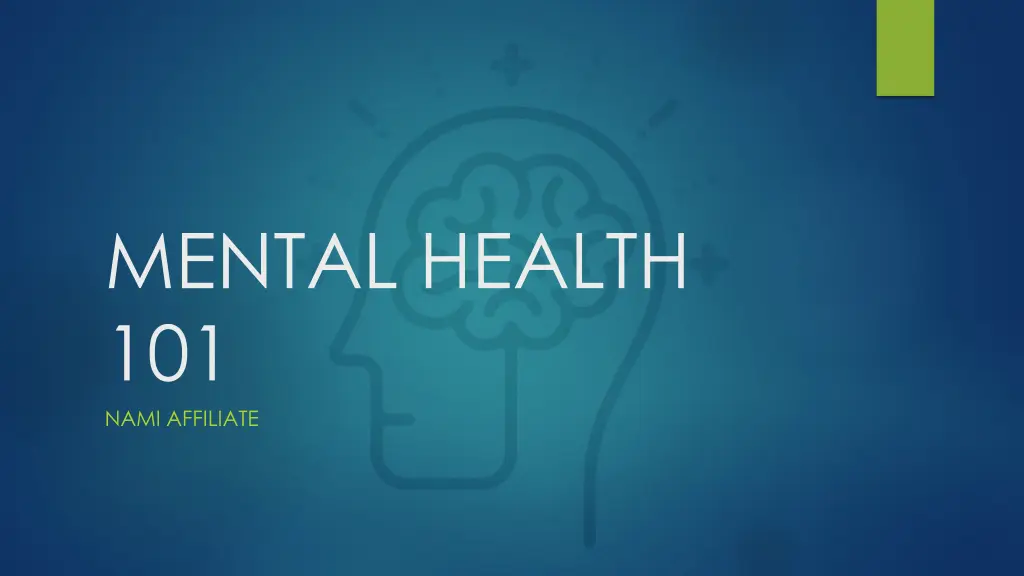
Understanding Mental Health and Mental Illness
Learn the differences between mental health and mental illness, how they affect individuals, and common mental health conditions. Explore the impact in North Carolina and gain insights into anxiety disorders, ADHD, bipolar disorder, borderline personality disorder, depression, dissociative disorders, eating disorders, and OCD.
Uploaded on | 2 Views
Download Presentation

Please find below an Image/Link to download the presentation.
The content on the website is provided AS IS for your information and personal use only. It may not be sold, licensed, or shared on other websites without obtaining consent from the author. If you encounter any issues during the download, it is possible that the publisher has removed the file from their server.
You are allowed to download the files provided on this website for personal or commercial use, subject to the condition that they are used lawfully. All files are the property of their respective owners.
The content on the website is provided AS IS for your information and personal use only. It may not be sold, licensed, or shared on other websites without obtaining consent from the author.
E N D
Presentation Transcript
MENTAL HEALTH 101 NAMI AFFILIATE
MENTAL HEALTH vs MENTAL ILLNESS Mental health and mental illness are NOT the same thing Mental Health How you think, feel, and act in order to face life s situations How you look at yourself, your life, and the people in your life How you evaluate options and make choices EVERYONE has mental health
MENTAL HEALTH vs MENTAL ILLNESS Mental Illness Impairment of the mind causing disruption in normal thinking, feeling, mood, behavior, or social interactions, and accompanied by significant distress or dysfunction, Each disorder is different in each person There is no have it or don t have it mental illness is a continuum or spectrum Mental health disorders vary from person to person and from time to time
BY THE NUMBERS North Carolina
THE IMPACT North Carolina
Mental Health Conditions Anxiety Disorders Everyone can experience anxiety, but when symptoms are overwhelming and constant often impacting everyday living it may be an anxiety disorder. Attention Deficit Hyperactivity Disorder (ADHD) ADHD is a developmental disorder defined by inattention (trouble staying on task, listening); disorganization (losing materials); and hyperactivity-impulsivity (fidgeting, difficulty staying seated or waiting). Bipolar Disorder Bipolar disorder causes dramatic shifts in a person's mood, energy and ability to think clearly. Individuals with this disorder experience extreme high and low moods, known as mania and depression. Some people can be symptom-free for many years between episodes. Borderline Personality Disorder BPD is characterized by a pattern of instability in emotions (commonly referred to as dysregulation), interpersonal relationships and self-image. Individuals with BPD can also struggle with impulsivity and self-harm.
Mental Health Conditions Depression Depression involves recurrent, severe periods of clear-cut changes in mood, thought processes and motivation lasting for a minimum of two weeks. Changes in thought processes typically include negative thoughts and hopelessness. Depression also involves affects sleep/energy, appetite or weight. Dissociative Disorders Dissociative disorders, which are frequently associated with trauma, disrupt every area of psychological functioning: consciousness, memory, identity, emotion, motor control and behavior. Eating Disorders Eating disorders are characterized by the intentional changing of food consumption to the point where physical health or social behaviors are affected. Obsessive-Compulsive Disorder OCD involves persistent, intrusive thoughts (obsessions) and repetitive behaviors that a person feels driven to perform (compulsions) in response to those thoughts.
Mental Health Conditions Posttraumatic Stress Disorder PTSD involves a set of physiological and psychological responses. It can occur in people who have experienced or witnessed a traumatic event such as a natural disaster, a serious accident, a terrorist act, rape, war/combat or something similar. Schizoaffective Disorder Schizoaffective disorder involves symptoms of schizophrenia, such as hallucinations or delusions, and symptoms of a mood disorder, such as depressive or manic episodes. Schizophrenia Schizophrenia interferes with a person s ability to think clearly, manage emotions, make decisions and relate to others. It also causes people to lose touch with reality, often in the form of hallucinations and delusions. Psychosis Psychosis is characterized as disruptions to a person s thoughts and perceptions that make it difficult for them to recognize what is real and what isn t. Psychosis is a symptom, not a condition.
She lives with bipolar disorder He experiences schizophrenia Person in recovery Survivor Person with lived experience A person living with a mental health condition She is being treated for He struggles with He died by suicide or She completed suicide She is bipolar Schizophrenic person Insane Psycho Crazy Mental patient Lunatic She suffers from He is a victim of He / She committed suicide The words you use to write about or discuss mental health are very important and can help reduce stigma around mental illness if carefully chosen. Always remember to focus on the person, not the condition
The only thing more exhausting than having a mental illness is pretending that you don t
TREATMENT OPTIONS MEDICATION OUTPATIENT PROGRAMS / COUNSELING ACUTE INPATIENT FACILITY RESIDENTIAL TREATMENT CENTER
MEDICATIONS Although psychiatric medications don t cure mental illness, they can significantly improve symptoms. They can also help make other treatments, such as, psychotherapy, more effective. The best medications for an individual will depend on their particular situation and how their body responds to the medication Types of medications Antidepressants Anti-anxiety Mood-stabilizing Antipsychotic
OUTPATIENT PROGRAMS Partial Hospitalization (PHP) and Intensive Outpatient (IOP) 0 1 Short-term programs for children, adolescents, and adults who are able to live in a supportive home environment while participating in programs to teach living and coping skills. 0 2 Addresses personal responsibility and positive interactions with family, school, and community. 0 3 Treats: Depression- Mood Swings- Anxiety- Anger Issues- Trauma- Substance Abuse- Social Skills Deficit
INPATIENT PROGRAMS Intensive psychiatric care designed to stabilize the patient s immediate crisis while providing the patient and family with skills to help prevent or minimize future events that would require readmission 0 1 Suicidal Thoughts- Depression- Anxiety- Anger/Rage- Trauma- Homicidal Thoughts- Substance Abuse- Hallucinations 0 2 Average length of stay 5-7 days
RESIDENTIAL TREATMENT CENTERS Long-term treatment for patients who have completed acute care inpatient programs and require additional treatment in a 24-hour therapeutic environment or for those who have not responded effectively to previous placements. Severe Emotional Disturbance- Suicidal Behaviors- PTSD- Oppositional Defiant- Mood Disorders- Sexually Abused- Personality Disorder- ADHD Average length of stay 6-12 weeks
RESISTANCE TO TREATMENT People don t always follow recommendations: Treatment is the person s choice Reinforcement and support helps Treatments effect different people differently Anosognosia - A neurological condition where a person is unable to perceive or is unaware of his or her own illness. Don t Judge Just find a different way!
NAMI is the nations largest grassroots mental health organization dedicated to building better lives for the millions of Americans affected by mental illness.
To improve the quality of life and ensure dignity and respect for persons with serious mental illness and offer support to their families and close friends. ~ NAMI mission
Local meetings of family members, caregivers, friends, and loved ones of individuals living with mental illness. Participants can talk frankly about their challenges and help one another through their learned wisdom. Peer-based mutual support groups that meet for 90 minutes of safe, confidential personal sharing in a flexible group setting. Groups are open to any adult who has experienced symptoms of a mental health condition and are designed to encourage and support participants using a structured support group model. Support Groups
50-minute mental health presentation for middle and high school aged youth available at no-cost to schools, youth clubs, and youth groups. Presented by a trained group consisting of: A young adult living with a mental health challenge, aged 18-35 An adult living in recovery with mental illness or family member of an individual living with mental illness Unique presentation in which two trained speakers share their compelling personal stories of living with mental health challenges and achieving recovery. presentation in which two trained speakers share their compelling personal stories of living with mental health challenges and achieving recovery. Presentations
Free, 8-session course taught by two trained volunteer teachers who themselves have a family member or loved one with a mental illness. Free, 8-session educational program for adults with a mental health condition who are looking to better understand their condition and journey toward recovery. Free, 6-week education program for parents and family caregivers of children and teens who are experiencing symptoms of a mental illness or who have already been diagnosed. Education Classes
Questions? NAME AFFILIATE EMAIL NUMBER

